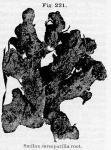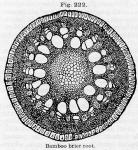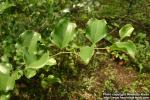![]() Preparations: Decoction of Sarsaparilla
- Compound Decoction of Sarsaparilla
- Fluid Extract of Sarsaparilla
- Compound Fluid Extract of Sarsaparilla
- Compound Syrup of Sarsaparilla
Preparations: Decoction of Sarsaparilla
- Compound Decoction of Sarsaparilla
- Fluid Extract of Sarsaparilla
- Compound Fluid Extract of Sarsaparilla
- Compound Syrup of Sarsaparilla
Related entries: Aralia nudicaulis—False Sarsaparilla
- Hemidesmus.—Indian Sarsaparilla
"The root of Smilax officinalis, Kunth; Smilax medica, Chamisso et Schlechtendal; Smilax papyracea, Duhamel; and of other, undetermined, species of Smilax"—(U. S. P.).
Nat. Ord.—Liliaceae.
COMMON NAMES: (See next page.)
ILLUSTRATION: (1 and 2) Bentley and Trimen, Med. Plants, 289, 290.
Botanical Source and History.—The Sarsaparillas are all climbing plants, having aculeate (prickly) stems; there are many species, but they do not all possess medicinal activity. Most of the drug-yielding species grow in the marshy forests of Mexico and the territory extending to the northern portion of Brazil. The botanical source of the sarsaparillas of commerce is not always exactly known; this, for example, is the case with Honduras sarsaparilla, which seems to be derived from several and partly undetermined species of Smilax, mostly from Smilax officinalis. The following species, however, are generally conceded to yield the drug in its various commercial forms.
Smilax officinalis has a twining, angular, prickly, and shrubby stem; the young shoots being unarmed. The leaves are ovate-oblong, acute, cordate, netted, 5 or 7-nerved, coriaceous, smooth, 1 foot long and 4 or 5 inches broad; the young ones are lanceolate, oblong, acuminate, and tri-nerved. The petioles are 1 inch long, smooth, bearing tendrils above the base. Flowers unknown. This plant grows in New Granada, on the banks of the Magdalena, was collected, in 1805, by Humboldt, and is called Sarzaparilla by the natives. Great quantities of it are sent to Carthagena, whence it is shipped to Jamaica, and, together with that coming from Central America (derived from Smilax ornata, Lemaire; see Pharm. Jour. Trans., 1889, p. 889), constitutes Jamaica sarsaparilla.
Smilax medica has an angular, zigzag, or flexuous stem, armed with straight aculei at the joints, and a few hooked ones in the intervals. The leaves are of the texture of paper, smooth, bright-green on each side, cordate, auriculate, shortly acuminate, and 5-nerved, with the veins of the underside prominent; form, being ovate, they are variable in somewhat panduriform, auriculate, and somewhat hastate, with the lobes of the base obtuse, sometimes obsolete, sometimes divaricating; their edges not straight, but as if irregularly crenate; the petioles and midrib are armed, when old, with straight, subulate prickles. The peduncles vary in length from 3 lines to 1 inch or more. The umbel is about 12-flowered, with the pedicels about 3 lines long. Schiede (1829) found this plant on the east slope of the Mexican Andes, where the root is gathered and then carried to Vera Cruz; it is supposed to furnish the Vera Cruz or Mexican sarsaparilla of commerce (L.).
Smilax papyracea has a 4-cornered, or plane-angular, polished, prickly stem; leaves somewhat membranous, oval-oblong, obtuse at both ends, or usually point-letted at the apex, quite entire, unarmed, and 5-ribbed, with 3 more prominent ribs. Cirrhi are inserted beneath the middle of the petiole. This plant grows in the province of Rio Negro and neighboring places, and yields the Brazilian or Para sarsaparilla.
Smilax syphilitica, Kunth, has a round, smooth stem, furnished only at the knots with 2 to 4 short, thick, straight prickles. The leaves are a foot long, oblong-lanceolate, acuminate, shining, coriaceous, 3-nerved, and terminated by a long point (L.). Humboldt and Bonpland discovered this plant on the rivers Cassiquiare and Rio Negro.
Description.—The Mexican and South American sarsaparillas have numerous long, delicate roots proceeding from one caudex or rhizome; they are usually taken from the ground with the caudex attached, and are frequently packed in a peculiar manner for exportation (see commercial grades, next page). Those roots which have a deep orange-red tint are preferred, but more especially those whose taste is acrid. The stronger this is, the better is the quality of the root. Water, either cold or hot, and also diluted alcohol, extracts its medicinal virtues, which, however, are materially injured by too great or long-continued heat. Sarsaparilla should never be purchased unless, after having chewed it for a few minutes, it leaves a distinct, persistent pungency or acrimony in the mouth and fauces; without this effect it can not be relied upon as an efficient article.
The official sarsaparilla is thus described: "About 4 or 5 Mm. (⅙ to ⅕ inch thick, very long, cylindrical, longitudinally wrinkled, externally grayish-brown, or orange-brown; internally showing a whitish and mealy, or somewhat horny, cortical layer, surrounding a circular wood-zone, the latter enclosing a broad pith; nearly inodorous; taste mucilaginous, bitterish, and acrid. The thick, woody, knotty rhizome, if present, should be removed"—(U. S. P.). Commercially, the sarsaparillas are best distinguished as mealy and non-mealy; the latter are preferred for medicinal purposes.
 Mealy Sarsaparillas.—HONDURAS SARSAPARILLA is a kind much esteemed, and more commonly employed in this country. It is imported from Belize, and other parts of the Bay of Honduras, in parcels 2 or more feet in length; the roots are folded into a kind of hank, and held neatly and closely together by tying some of the roots transversely around those forming the parcel. These parcels, weighing from 2 to 20 pounds, are formed into large packages, weighing from 80 to 120 pounds, which are partially enveloped in hide or skin. The roots have a few rootlets attached, are bearded, of a grayish or reddish-brown color, approaching orange, and have a very mealy cortex.
Mealy Sarsaparillas.—HONDURAS SARSAPARILLA is a kind much esteemed, and more commonly employed in this country. It is imported from Belize, and other parts of the Bay of Honduras, in parcels 2 or more feet in length; the roots are folded into a kind of hank, and held neatly and closely together by tying some of the roots transversely around those forming the parcel. These parcels, weighing from 2 to 20 pounds, are formed into large packages, weighing from 80 to 120 pounds, which are partially enveloped in hide or skin. The roots have a few rootlets attached, are bearded, of a grayish or reddish-brown color, approaching orange, and have a very mealy cortex.
GUATEMALA SARSAPARILLAclosely resembles the Honduras drug, being packed in a similar manner. Its orange color is, however, more decided, and its bark has a tendency to split and crack off, exposing the central ligneous column. It appeared in commerce about 1852—(Pharmacographia).
BRAZILIAN SARSAPARILLA(Para, Lisbon or Rio Negro sarsaparilla).—This variety is now less esteemed than formerly. "It is packed in a very distinctive manner, the roots being tightly compressed into a cylindrical bundle, 3 feet or more in length, and, about 6 inches in diameter, firmly held together by the pliable stem of a bignoniaceous plant, closely wound round them, the ends being neatly shaved off"—(Pharmacographia). Its place of export is Para.
CARACAS SARSAPARILLAis also a mealy variety, resembling the preceding kind.
Non-Mealy Sarsaparillas.—JAMAICA SARSAPARILLA (Bearded sarsaparilla, Red sarsaparilla). "This drug consists of roots, 6 feet or more in length, bent repeatedly so as to form bundles of 18 inches long and 4 in diameter, which are secured by being twined round (but less trimly and closely than the Honduras sort) with a long root of the same drug. The rhizome is entirely absent, but the fibre or beard is preserved, and is reckoned a valuable portion of the drug. The roots are deeply furrowed, shrunken, and generally more slender than in the Honduras kind; the bark, when shaved off with a penknife, is seen to be brown, hard, and non-mealy throughout. Yet it is by no means uncommon to find roots which have a smooth bark rich in starch. In color, Jamaica sarsaparilla varies from a pale earthy-brown to a deeper ferruginous hue, the latter tint being the most esteemed"—(Pharmacographia). This drug (Sarsae radix) is the official one of the British Pharmacopoeia, and grows in the Isthmus of Panama, upon the mountains known as the Cordillera of Chiriqui, bordering on Costa Rica. Being exported through Jamaica, it has received the name of that place. Botanically, it is derived from Smilax ornata, Hooker filius.
MEXICAN SARSAPARILLA(Vera Cruz or Tampico sarsaparilla).—Roots thin and shriveled, very fragile, pale dull-brown in color. Contains very little starch, but possesses considerable acridity. The plant grows in Papantla, Tuxpan, Nantla, etc., and is usually shipped at Vera Cruz and Tampico, being put up in large bales weighing from 150 to 200 pounds. The roots are not tied around the rhizome transversely, but merely envelop it longitudinally. The inside often contains earth and stone.
GUAYAQUIL SARSAPARILLA, from Ecuador via Guayaquil, is crudely packed in large bales, and is not generally made into separate hanks. "The rhizome (chump) and a portion of the stem are often present, the latter being round and not prickly. The root is dark, large, and coarse-looking, with a good deal of fibre. The bark is furrowed, rather thick, and not mealy in the slender portions of the root, which is near the rootstock, but as the root becomes stout, so its bark becomes smoother, thicker, and amylaceous, exhibiting, when cut, a fawn-colored or pale-yellow interior"—(Pharmacographia).
Chemical Composition.—Besides volatile oil (Pareira, Mat. Med.), resin, starch, coloring matter, calcium oxalate, etc., sarsaparilla root contains several glucosids, to which its peculiar properties are due. According to Kobert (1892), these glucosids are: (1) Parillin of Palotta (1824), first obtained pure by Flückiger, previously also called smilacin (not Merck's), salseparin, and parillic acid; it is crystalline, nearly insoluble in cold water, soluble in 20 parts of boiling water, forming a bitter solution, which froths upon shaking; it is the least active of the glucosids. Flückiger (see Husemann and Hilger, Pflanzenstoffe, p. 408) obtained about 0.19 per cent. Boiling with diluted sulphuric acid produces sugar and parigenin, insoluble in water. (2) Saponin (sarsaparill-saponin; smilacin of Merck) is amorphous, more active than the preceding, soluble in water and alcohol. (3) Sarsa-saponin, crystallizing in needles, readily soluble in water; the most poisonous of the three.
Action, Medical Uses, and Dosage.—Sarsaparilla is generally considered as an alterative, though stated by some to possess diuretic, diaphoretic, and emetic properties. Its mode of action, however, is not well understood, as it effects normal changes in the system without any appreciable change in the operation of the various organs. No medicine has, probably, ever passed through so many changes of popularity, having been at various times most highly lauded as an efficient alterative, and as often been pronounced inert. There is no doubt, however, that, when properly prepared, it exerts a favorable influence over the system. The diseases in which it has been more particularly recommended, are inveterate syphilis, pseudo-syphilis, mercurio-syphilis, and struma in all its forms. It has been used in several chronic diseases, as of the skin, as herpes (best associated with sodium sulphite), rheumatic affections (with potassium iodide), passive general dropsy, gonorrhoeal rheumatism, and other depraved conditions of the system where an alterative is required. The decoction, made acid with nitric acid, is serviceable in syphilitic sore throats, and, acidulated with hydrochloric acid, is of some value in chronic hepatic disorders, with torpor. A drink is made in Angostura, which enjoys much reputation there as an alterative beverage. It is made of Rio Negro sarsaparilla, 1 pound; rasped guaiac wood, 6 ounces; aniseed and bruised liquorice root, of each, 2 ounces; mezereon root-bark, 1 ounce; molasses, 1 pound; and ½ dozen bruised cloves; pour upon these articles 2 gallons of boiling water, and shake the vessel 3 times a day. As soon as fermentation begins, it may be taken in doses of 4 fluid ounces, 2 or 3 times a day (C.—Trans. Med. Bot. Soc., 1829). At the present day, sarsaparilla is but little used as above. Probably much of good that has been accomplished with sarsaparilla mixtures has been chiefly due to the active ingredients that have been so frequently associated with it. Dose of sarsaparilla, in powder, 30 grains, 3 or 4 times a day; of the infusion or syrup, 4 fluid ounces. Some believe sarsaparilla to contain an active cardiac-sedative principle.
 Related Species.—Smilax sarsaparilla, Linné, is "of doubtful origin, and so far as growing in the United States, it is not now recognized "(Walter Evans, Lilly's Bulletin, No. 16, Aug., 1891).
Related Species.—Smilax sarsaparilla, Linné, is "of doubtful origin, and so far as growing in the United States, it is not now recognized "(Walter Evans, Lilly's Bulletin, No. 16, Aug., 1891).
Smilax Tamnoides, Linné.—Indigenous. Tubers used like sarsaparilla.
 BAMBOO BRIER, Virginia Sarsaparilla.—Of this species Prof. King (American Dispensatory, 11th ed.) says: "There is a plant in the south extensively known as Bamboo brier, the root of which I have much used in practice, and with decidedly more successful results than from the use of any of the sarsaparillas of the shops, and I invite the attention of physicians to it, as a remedy in every respect superior to the usual commercial article, especially in primary and secondary syphilitic diseases."
BAMBOO BRIER, Virginia Sarsaparilla.—Of this species Prof. King (American Dispensatory, 11th ed.) says: "There is a plant in the south extensively known as Bamboo brier, the root of which I have much used in practice, and with decidedly more successful results than from the use of any of the sarsaparillas of the shops, and I invite the attention of physicians to it, as a remedy in every respect superior to the usual commercial article, especially in primary and secondary syphilitic diseases."
This plant is derived from Smilax lanceolata, Linné, and, according to W. H. Evans (loc. cit.) has been confused with Smilax Pseudo-China, Linné. The stem is tall, often 30 to 40 feet, mostly unarmed; the branches are round, unarmed; leaves evergreen, paler beneath, rather thin, lanceolate to ovate-lanceolate, acute at each end, 3 to 5-ribbed, margin smooth, petiole short, most often without tendrils; the peduncles are short; flowers in May; the berries are 3-seeded, black when ripe; mature from August to September. This species grows in rich woods and swamps, where the entire rhizome frequently weighs 200 to 300 pounds when fresh. It grows from Virginia to Florida, and west to Arkansas and Texas (Lilly's Bulletin, No. 16, Aug., 1891). It was employed by the Indians as an antisyphilitic, and by the whites as a "blood purifier." Rheumatism, scrofula, and cutaneous affections are said to be cured by it. A decoction maybe freely used. (See illustration, next page.)
 Smilax China, Linné, has a hard, large, knotty, uneven rhizome, brown or blackish externally, whitish within. Stem tapering, slightly prickly, growing 2 or 3 feet high without support, but acquiring a greater length if scrambling among bushes. Leaves thin, membranous, roundish, 5-nerved, acute or obtuse at each end, mucronate at the point; stipules distinct, obtuse. Umbels small, 10-flowered, greenish-yellow. Fruit red, about the size of a bird cherry (L.). This plant grows in eastern Asia (China and Japan), and furnishes the China root (Rhizoma [radix] Chinae) of commerce. It has been used as a substitute for sarsaparilla, but is found not to be as active. It occurs in large, ligneous, knotty pieces, from 2 to 6 or more inches in length, and 1 to 2 inches in diameter; externally, it is grayish-brown; internally, a light-flesh, or yellowish-white color. It is inodorous, and has a slightly astringent taste (P.).
Smilax China, Linné, has a hard, large, knotty, uneven rhizome, brown or blackish externally, whitish within. Stem tapering, slightly prickly, growing 2 or 3 feet high without support, but acquiring a greater length if scrambling among bushes. Leaves thin, membranous, roundish, 5-nerved, acute or obtuse at each end, mucronate at the point; stipules distinct, obtuse. Umbels small, 10-flowered, greenish-yellow. Fruit red, about the size of a bird cherry (L.). This plant grows in eastern Asia (China and Japan), and furnishes the China root (Rhizoma [radix] Chinae) of commerce. It has been used as a substitute for sarsaparilla, but is found not to be as active. It occurs in large, ligneous, knotty pieces, from 2 to 6 or more inches in length, and 1 to 2 inches in diameter; externally, it is grayish-brown; internally, a light-flesh, or yellowish-white color. It is inodorous, and has a slightly astringent taste (P.).
Smilax Aspera, Linné.—South Europe. Employed like sarsaparilla.
Smilax Pseudo-China, Linné, False China root, China brier, American China root, China root of Mexico.—Grows in New Jersey and west to southern Indiana and Missouri, south to Florida and the West Indies. The root is also used in Mexico, and regarded as diaphoretic and antisyphilitic. It is official in the Mexican Pharmacopoeia, under the name Raiz de China de Mexico (Smilax Pseudo-China, Schlechtendal).
A FALSE JAMAICA SARSAPARILLA, a species of Philodendron, is described by C. Hartwich (Archiv der Pharm., 1894; also see Pharm. Jour. Trans., Vol. VII, 1898, p. 583).
Carex Arenaria, Linné, German sarsaparilla, Sand sedge.—Europe. The long, creeping rhizome of this plant was at one time used like sarsaparilla for its effects in syphilis, rheumatism, gout, lung and skin diseases, its effects being exerted chiefly through the skin and kidneys. The decoction was employed.
Carex hirta and Carex intermedia were put to similar uses.
Arenaria rubra is a popular diuretic, in use among the Algerians, in dropsy and affections of the urinary organs.
CARNAUBA ROOT.—The long root of a wax-palm (Corypha cerifera) of Brazil. It resembles sarsaparilla in action, and contains an alkaloid, essential oil (both in small amounts), tannic acid, an acrid resin, and red coloring principle (Cleaver).

